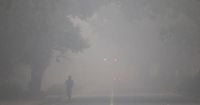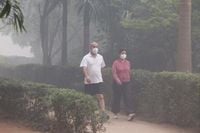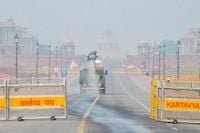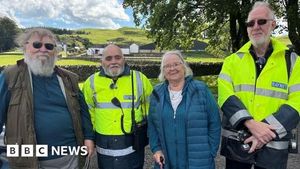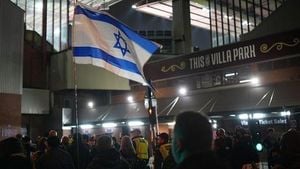On the morning of October 22, 2025, nearly 20 million residents of New Delhi awoke to a city engulfed in a dense, choking smog, marking one of the most polluted days in recent memory. The Central Pollution Control Board (CPCB) reported an Air Quality Index (AQI) of 345 at 5:30 a.m., a level classified as ‘very poor’ and, for many neighborhoods, the air was far worse. In Ashok Vihar, Bawana, and Dilshad Garden, early readings soared to around 380, while the previous day saw four stations—including Dwarka and Wazirpur—plunge into the ‘severe’ category with AQIs surpassing 400. At some monitoring points, such as Mandir Marg and Lodhi Road, readings even surged past 1,300, a level considered hazardous for everyone, not just those with respiratory or heart conditions, according to The Independent.
This dramatic spike in pollution followed the exuberant celebrations of Diwali, the Hindu festival of lights, which traditionally involves the widespread use of fireworks and firecrackers. Despite a decade-long ban on pyrotechnics, this year the Supreme Court permitted the sale and bursting of so-called ‘green’ firecrackers—purported to emit 30% fewer pollutants—within tightly specified windows on Diwali eve and the festival day. However, as CNN and The Independent reported, enforcement was lax: heavy fireworks continued well past midnight, and non-green firecrackers were still widely available. Many residents described the regulations as a mere formality, with one, Anushka Singh, noting, “Year on year, it goes from bad to worse. Living in Delhi is a pain… I just wish that given the decades of data we would at least have stricter rules, ones that are actually implemented.”
As the haze settled, the city’s 24-hour average AQI climbed to 345, up from 326 just two days earlier. The spike was not unexpected. According to IQAir, New Delhi’s PM 2.5 concentration—tiny particles capable of penetrating deep into the lungs—was more than 40 times higher than the World Health Organization’s annualized guideline. In fact, on October 22, Delhi, Kolkata, and Mumbai were all ranked among the world’s most polluted cities.
While the immediate culprit was the Diwali festivities, experts and officials pointed to a toxic cocktail of factors fueling the city’s annual air crisis. Low wind speeds and stagnant weather trapped pollutants close to the ground. Emissions from firecrackers, laced with sulfur oxides, nitrogen oxides, and heavy metals, mixed with seasonal pollution from vehicular traffic, construction dust, and the burning of crop residue in neighboring states like Punjab and Haryana. The Decision Support System (DSS) attributed 15.6% of Delhi’s pollution on October 20 to transport, with industries and other sources contributing 23.3%.
Despite the Supreme Court’s intention to balance tradition and public health, the fallout was severe. Hospitals across Delhi reported a surge in patients suffering from respiratory issues, asthma attacks, bronchitis, and even pneumonia. Dr. Kuldeep Kumar Grover at CK Birla Hospital in Gurugram treated at least 15 elderly patients with pneumonia or respiratory failure in the days following Diwali, with five requiring hospitalization. “Cases with sudden onset of breathlessness and cough are increasing, and given the current situation, we expect this trend to rise further,” Dr. Grover told The New Indian Express. Neonatologist Dr. Anamika Dubey of Rainbow Children’s Hospital warned that “these pollutants can stay in the air long after the fireworks are over, creating thick smog that can seriously harm babies and young children. Their lungs and immune systems are still developing, which means they breathe faster and take in more air for their body size. This makes them especially vulnerable to pollution-related damage.”
Health experts urged the public—especially children, the elderly, and those with preexisting respiratory conditions—to limit outdoor exposure and wear protective masks. Residents described a litany of symptoms: burning eyes, scratchy throats, difficulty breathing, and, for some, joint pain and flu-like complaints. Sagar, a local resident, put it bluntly: “Pollution hasn’t just increased today; it’s been rising for years. Everyone blames politicians, but people themselves are responsible. Firecrackers are a choice—then people complain the government isn’t doing anything.”
The political fallout was swift and sharp. Lawmaker Priyanka Chaturvedi publicly blamed the city’s wealthier residents for setting off “revenge fireworks” after the ban was lifted, suggesting that those who could afford such displays also had the means to protect themselves with air purifiers. “My only worry is about the people sleeping on the footpath, small homes with no access to purifiers, hope we have left them with some clean air to breathe, can also hope they will save enough money to buy their own purifiers. Because it is them who rise up everyday to keep the country going,” she wrote on X (formerly Twitter). Meanwhile, a viral photo of Prime Minister Narendra Modi sitting beside a luxury air purifier fueled public outrage over the stark contrast between the comfort of elected leaders and the suffering of ordinary citizens.
Authorities scrambled to respond. The Commission for Air Quality Management (CAQM) indicated that Stage II of the Graded Response Action Plan (GRAP) was now in effect across Delhi-NCR. Under GRAP-II, stricter curbs include a ban on the use of diesel generators (except for essential services), tighter regulations on construction and demolition activities, and enhanced dust suppression efforts. Special task forces were deployed in pollution hotspots to manage vehicular emissions and traffic flow. Still, as history has shown, these measures often struggle against the scale and persistence of the problem.
Delhi’s air pollution crisis is not new. Over the years, authorities have tried everything from sprinkling water on roads to constructing two massive smog towers in 2018, costing 200 million rupees (about $2.4 million), to odd-even traffic schemes. Yet, as environmental activist Bhavreen Kandhari told the Hindustan Times, “With nearly every monitoring station in Delhi now in the red zone, this is a wake-up call. Today’s smog isn’t just clouding the sky; it is choking our children’s lungs.”
The consequences are dire and far-reaching. According to a report by the Energy Policy Institute at the University of Chicago, air pollution in Delhi reduces the average life expectancy of its residents by around 12 years compared with levels deemed safe by the WHO. As Aarti Khosla, founder and director of Climate Trends, observed in India Today: “It’s disheartening that even after years of witnessing the harmful effects of burning firecrackers during Diwali, we continue to deny the reality and repeat the same mistake. As individuals, we often overlook how severely this pollution impacts health, especially that of children, pregnant women, the elderly, and those who’re unwell.”
Adding to the tragedy, the festival’s chaos also sparked violence: in one case, a 30-year-old man named Dileep was stabbed to death in the Shahbad Dairy area after an argument over fireworks, according to police reports cited by The Indian Express.
Delhi’s post-Diwali smog is a stark reminder that the city’s air pollution crisis is both chronic and acute, shaped by tradition, policy, enforcement gaps, and the choices of millions. The haze may eventually lift, but the questions it raises about health, equity, and responsibility linger—thicker than any cloud of smoke.
